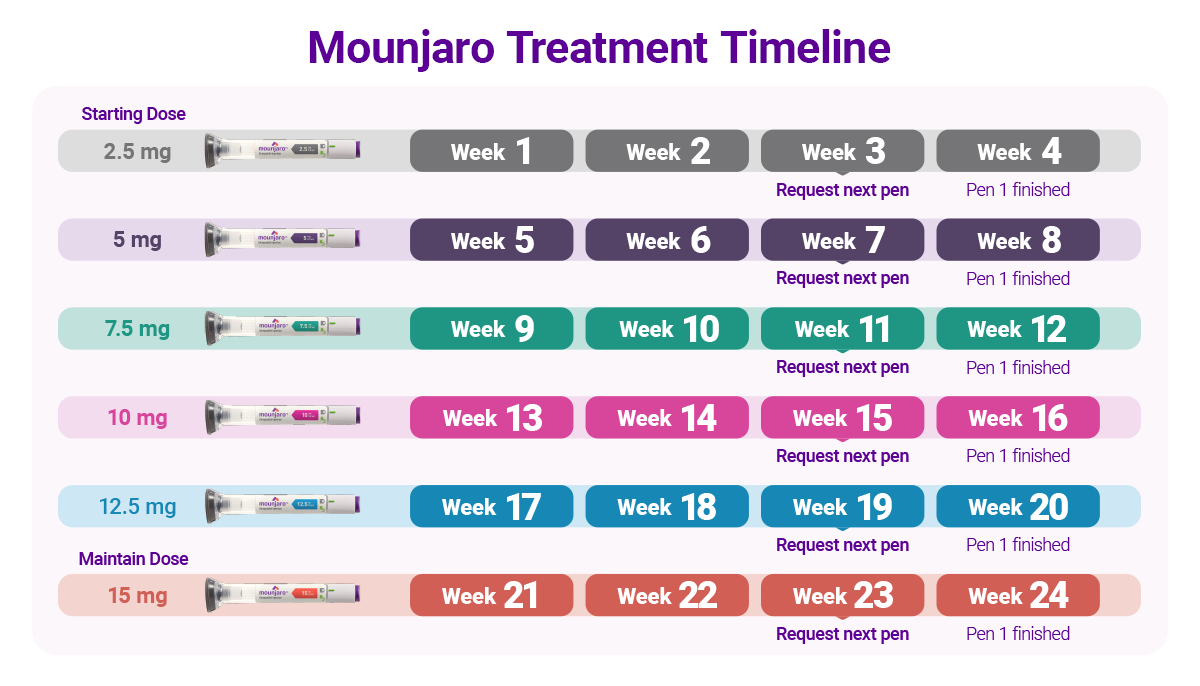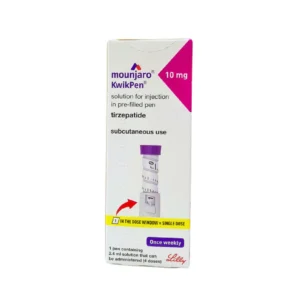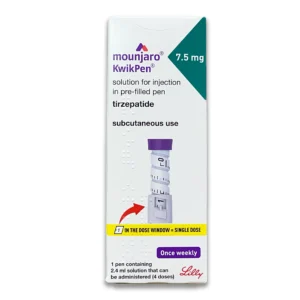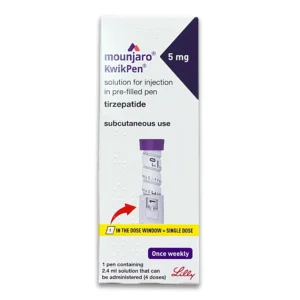Mounjaro is a once a weekly injection to help adults manage their weight. It works by regulating appetite by reducing food cravings, hunger & giving a sense of satiety (fullness).
£270.00
Mounjaro is a prescription injectable medication that can assist adults with obesity, or those who are overweight and dealing with weight-related health issues, in losing weight and maintaining weight loss. It is also effective for patients with type 2 diabetes in managing high blood sugar levels.
The Mounjaro KwikPen is a disposable, pre-filled pen intended for single-patient, multi-dose use. Each pen holds enough medication for 4 weekly doses, meaning you will need one pen per month.
Mounjaro contains tirzepatide as its active ingredient. Tirzepatide helps reduce your appetite, making you feel full for longer. This decrease in hunger leads to fewer food cravings, and by eating less, it aids in weight loss.
| Weight | 0.25 kg |
|---|
Always use Mounjaro exactly as directed in the patient information leaflet or as advised by your doctor or Fylde Clinic pharmacist.
Mounjaro should be taken once a week on the same day, though you can choose any time during that day for your injection. If needed, you can change the day of your weekly dose, ensuring that there is at least a 7-day gap between doses.
If you miss a dose, take it as soon as possible within 96 hours (4 days). If more than 4 days have passed, skip the missed dose and continue with your next scheduled dose. Do not take two doses within 72 hours (3 days) of each other.

All the above For £0.99 p
Used needles must be placed in a sharps disposal container immediately after use. Do not dispose of needles in household waste to prevent injury and contamination. Once you have used your Mounjaro KwikPen four times (one month’s use), discard the pen (without the needle) in your regular household bin.
For further details, including illustrated instructions, refer to the patient information leaflet.
Like all medications, Mounjaro may cause side effects in some individuals, though not everyone will experience them. Common side effects include:
For a full list of potential side effects, please refer to the patient information leaflet. If you experience any side effects, including those not listed in the leaflet, you can report them through the MHRA Yellow Card Scheme.
Seek immediate medical attention if you develop signs of a severe allergic reaction, such as swelling of the face or throat, a skin rash, difficulty breathing, or loss of consciousness.
Some individuals using Mounjaro have reported severe stomach issues. Inform your healthcare provider if you experience persistent or severe stomach problems.
Nausea, vomiting, and diarrhea can lead to dehydration, which may cause kidney complications. Ensure you stay hydrated by drinking plenty of fluids.
Gallbladder issues have also been reported in some users of Mounjaro. Contact your healthcare provider immediately if you experience symptoms such as:
Additionally, inflammation of the pancreas (pancreatitis) is a potential risk. Stop using Mounjaro and seek medical advice if you develop severe, persistent abdominal pain, with or without vomiting, which may radiate to your back.
Patients with type 2 diabetes may experience vision changes while taking Mounjaro. Inform your healthcare provider if you notice any alterations in your vision.
It is also important to monitor your mental health while using this medication. If you experience any new or worsening mood changes, behavioral shifts, or troubling thoughts, contact your healthcare provider promptly.
Mounjaro may be unsuitable for certain people. Do not use this medicine if you are allergic to tirzepatide or any of the other listed ingredients.
Do not use Mounjaro if you or any of your family have ever had a type of thyroid cancer called MTC or if you have an endocrine system condition called MEN 2.
Talk to your doctor or pharmacist before taking this medicine if you:
You must tell your doctor or pharmacist about all the medicines you take, including prescription and over-the-counter (OTC) medicines, vitamins and herbal supplements before using Mounjaro.
This is because Mounjaro may affect the way some medicines work, and some medicines may affect the way Mounjaro works.
Your risk for getting low blood sugar may be higher if you use Mounjaro with medicines that can cause low blood sugar, such as a sulfonylurea or insulin. Signs and symptoms of low blood sugar may include:
Mounjaro is only suitable for adults aged 18 years and over.
Store unused Mounjaro pens in the fridge between 2°C and 8°C, in the original carton until ready to use; this protects it from the light. Unused pens may be used until their expiry date as long as they have been kept in the fridge.
You may store your used pen at room temperature up to 30°C after your injection. Keep away from heat and out of sight and reach of children. Dispose of the pen 30 days after first use. Dispose of the pen after receiving 4 weekly doses.
Do not use after the expiry date, referring to the last day of the month stated on the packaging. Do not throw away any medicines via wastewater or household waste.
You must be logged in to post a review.




mateen8325 –
Good